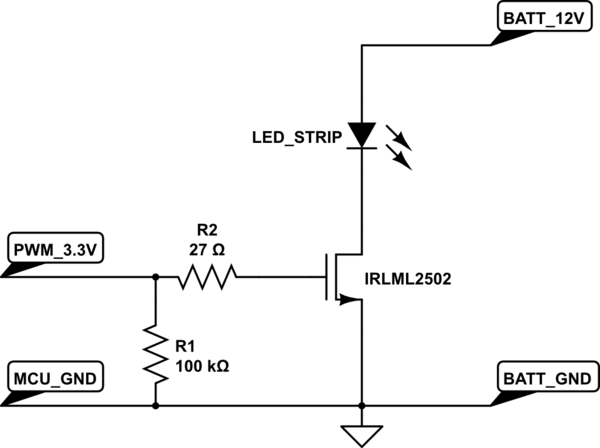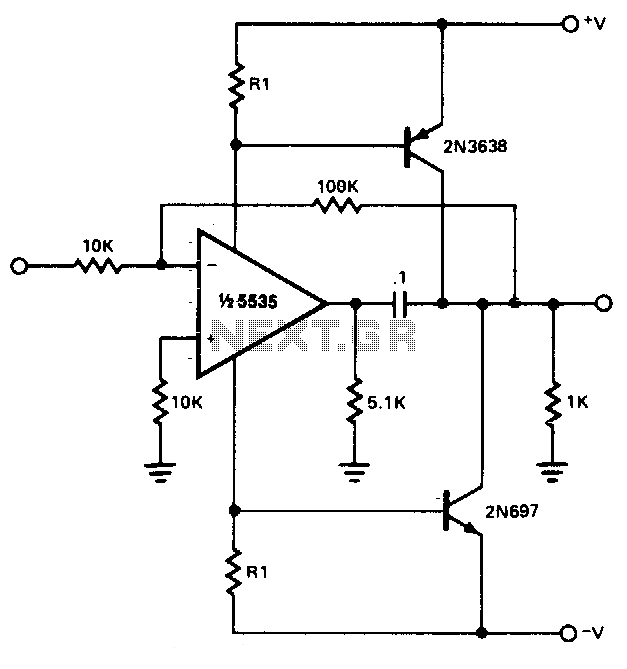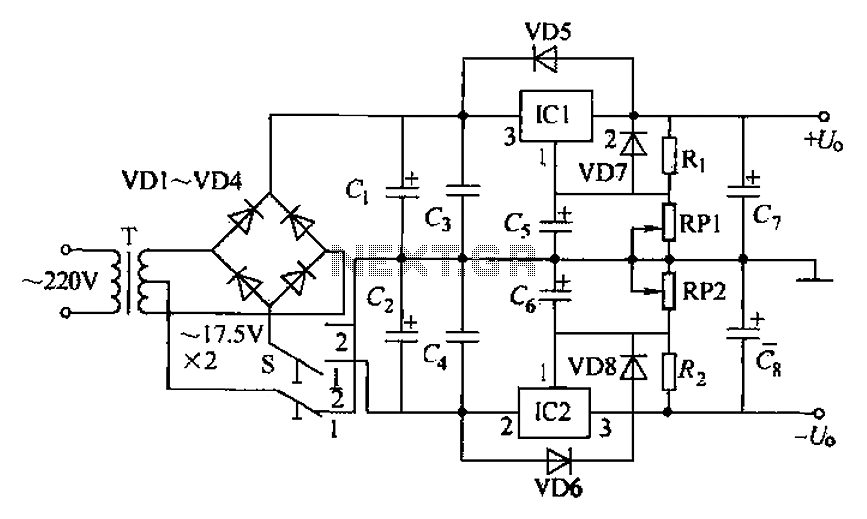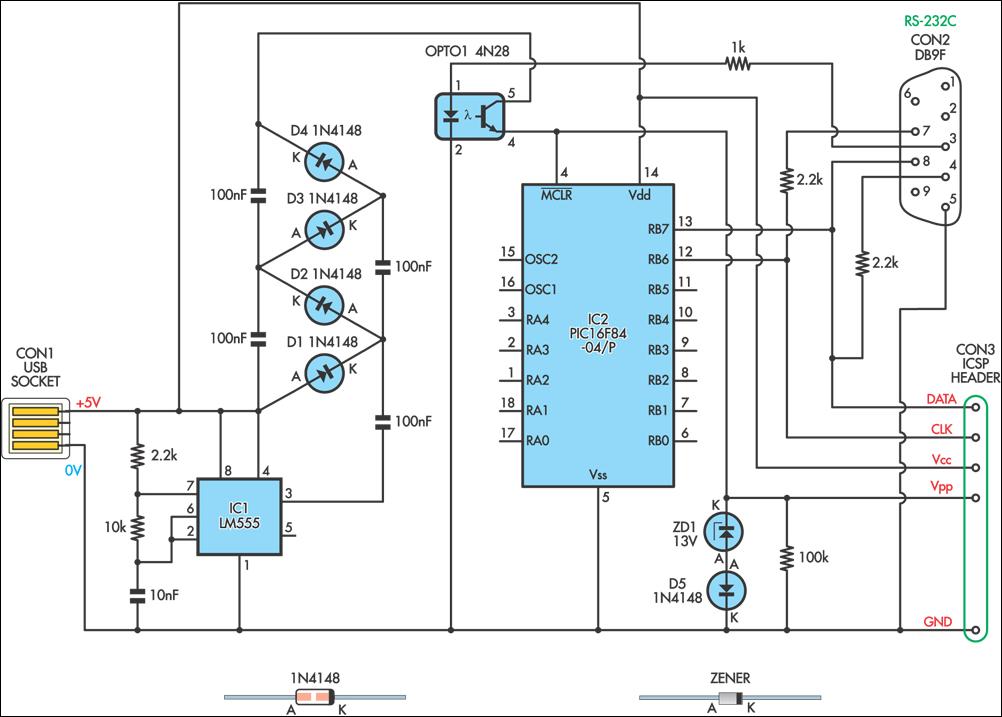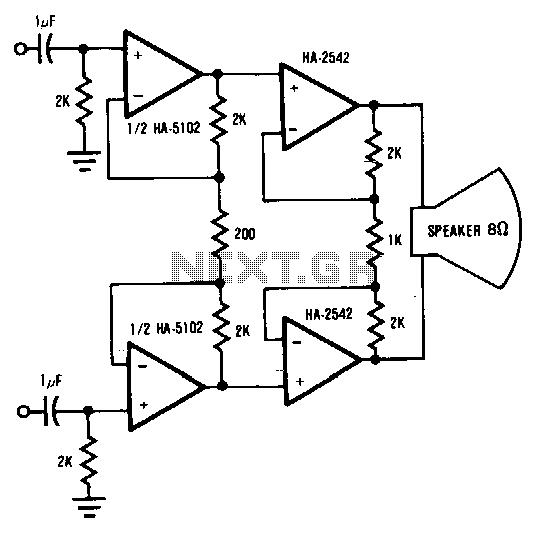
Power MOSFET Bridge Rectifier
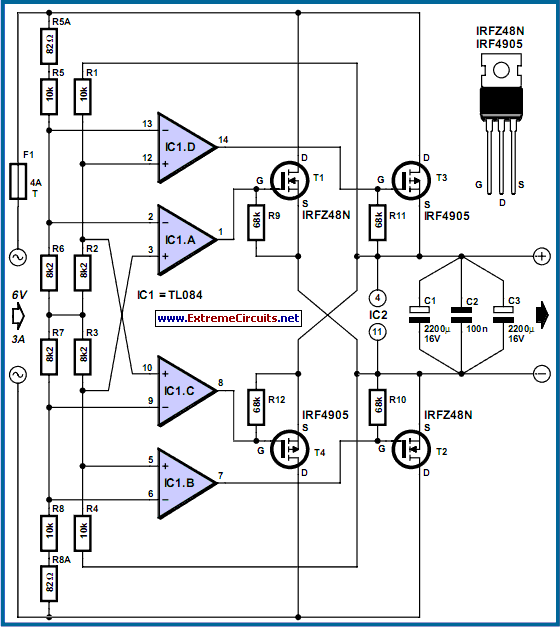
The losses in a bridge rectifier can become significant when low voltages are being rectified. The voltage drop across the bridge is approximately 1.5 V, which represents about 25% of an input voltage of 6V. The loss can be reduced by around 50% by using Schottky diodes, but achieving nearly zero loss is possible with a synchronous rectifier. This involves using an active switching system instead of a passive bridge rectifier. The principle is straightforward: whenever the instantaneous value of the input AC voltage exceeds the rectified output voltage, a MOSFET is activated to allow current to flow from the input to the output. For a full-wave rectifier, four FETs are required instead of four diodes, similar to a bridge rectifier. Resistors R1 and R4 form a voltage divider for the rectified voltage, while R5 and R8 do the same for the AC input voltage. When the input voltage slightly exceeds the rectified voltage, IC1d activates MOSFET T3. As in a conventional bridge rectifier, the MOSFET diagonally opposite T3 must also be activated simultaneously, which is managed by IC1b. The polarity of the AC voltage reverses during the next half-wave, prompting IC1c and IC1a to activate T4 and T1, respectively. The voltage dividers are not fully symmetrical; the input voltage is slightly reduced to create a delay in switching on the FETs, which is preferable to premature activation that could increase losses. It is advisable to use 1% resistors for the dividers, or even 0.1% resistors if available. The control circuit surrounding the TL084 is powered from the rectified voltage, eliminating the need for an auxiliary supply. Initially, there will be no voltage, so the rectifier will not operate, creating a potential issue. However, the internal structures of the FETs include internal diodes, depicted in dashed outline for clarity, which facilitate circuit startup, albeit with some losses. The selection of FETs is not critical; any available type can be used, but the internal resistance will affect losses. Currently, FETs with an internal resistance of 20 to 50 mΩ are common and can handle currents around 50 A. While an average current of 5 A can lead to peak currents of 50 A in the FETs, the IRFZ48N (55 V @ 64 A, 16 mΩ) specified by the author is outdated but may still be obtainable, or alternatives such as the IRF4905 can be employed, which supports 55 V @ 74 A with an internal resistance of 20 mΩ. For voltages exceeding 6 V, it is advisable to increase the value of the 8.2 kΩ resistors, for example, to 15 kΩ for 9V or 22 kΩ for 12 V.
In the design of a synchronous rectifier circuit, the choice of components and their arrangement is crucial for optimal performance. The use of MOSFETs instead of diodes allows for a significant decrease in voltage drop and associated power loss. The circuit is structured to ensure that the MOSFETs are activated in a coordinated manner, which is essential for maintaining efficiency during both halves of the AC cycle. The voltage dividers R1, R4, R5, and R8 play a critical role in determining the switching thresholds for the MOSFETs by providing feedback to the control IC (TL084). The careful selection of resistor values is necessary to ensure that the switching occurs at the optimal times, preventing losses associated with premature activation.
The internal diodes of the MOSFETs are particularly advantageous during the startup phase, allowing the circuit to begin operation even in the absence of a rectified voltage. This feature is vital for ensuring that the synchronous rectifier can start functioning as soon as AC power is applied. The design also considers the thermal management of the FETs, as they will experience varying currents that can lead to heating. Adequate heat dissipation methods, such as heat sinks, should be employed to maintain the reliability and longevity of the FETs.
When selecting FETs, it is important to consider not only their voltage and current ratings but also their on-resistance, as this directly impacts efficiency. The IRF4905 is a suitable alternative to the IRFZ48N, and its specifications should be matched to the requirements of the application. The adjustment of resistor values for different input voltages ensures that the circuit remains adaptable and maintains performance across a range of operating conditions. Overall, the synchronous rectifier circuit presents a modern solution to the inherent losses associated with traditional bridge rectifiers, making it an attractive choice for low-voltage applications.The losses in a bridge rectifier can easily become significant when low voltages are being rectified. The voltage drop across the bridge is a good 1. 5 V, which is a hefty 25% with an input voltage of 6V. The loss can be reduced by around 50% by using Schottky diodes, but it would naturally be even nicer to reduce it to practically zero.
That`s pos sible with a synchronous rectifier. What that means is using an active switching system instead of a passive` bridge rectifier. The principle is simple: whenever the instantaneous value of the input AC voltage is greater than the rectified output voltage, a MOSFET is switched on to allow current to flow from the input to the output. As we want to have a full-wave rectifier, we need four FETs instead of four diodes, just as in a bridge rectifier.
R1 R4 form a voltage divider for the rectified voltage, and R5 R8 do the same for the AC input voltage. As soon as the input voltage is a bit higher than the rectified voltage, IC1d switches on MOSFET T3. Just as in a normal bridge rectifier, the MOSFET diagonally opposite T3 must also be switched on at the same time.
That`s taken care of by IC1b. The polarity of the AC voltage is reversed during the next half-wave, so IC1c and IC1a switch on T4 and T1, respectively. As you can see, the voltage dividers are not fully symmetrical. The input voltage is reduced slightly to cause a slight delay in switching on the FETs. That is better than switching them on too soon, which would increase the losses. Be sure to use 1% resistors for the dividers, or (if you can get them) even 0. 1% resistors. The control circuit around the TL084 is powered from the rectified voltage, so an auxiliary supply is not necessary.
Naturally, that raises the question of how that can work. At the beginning, there won`t be any voltage, so the rectifier won`t work and there never will be any voltage. Fortunately, we have a bit of luck here. Due to their internal structures, all FETs have internal diodes, which are shown in dashed outline here for clarity.
They allow the circuit to start up (with losses). There`s not much that has to be said about the choice of FETs it`s not critical. You can use whatever you can put your hands on, but bear in mind that the loss depends on the internal resistance. Nowadays, a value of 20 to 50 mW is quite common. Such FETs can handle currents on the order of 50 A. That sounds like a lot, but an average current of 5 A can easily result in peak currents of 50 A in the FETs.
The IRFZ48N (55 V @ 64 A, 16 mW) specified by the author is no longer made, but you might still be able to buy it, or you can use a different type. For instance, the IRF4905 can handle 55 V @ 74 A and has an internal resistance of 20 mR. At voltages above 6 V, it is recommended to increase the value of the 8. 2-kR resistors, for example to 15 kR for 9V or 22 kR for 12 V. 🔗 External reference
In the design of a synchronous rectifier circuit, the choice of components and their arrangement is crucial for optimal performance. The use of MOSFETs instead of diodes allows for a significant decrease in voltage drop and associated power loss. The circuit is structured to ensure that the MOSFETs are activated in a coordinated manner, which is essential for maintaining efficiency during both halves of the AC cycle. The voltage dividers R1, R4, R5, and R8 play a critical role in determining the switching thresholds for the MOSFETs by providing feedback to the control IC (TL084). The careful selection of resistor values is necessary to ensure that the switching occurs at the optimal times, preventing losses associated with premature activation.
The internal diodes of the MOSFETs are particularly advantageous during the startup phase, allowing the circuit to begin operation even in the absence of a rectified voltage. This feature is vital for ensuring that the synchronous rectifier can start functioning as soon as AC power is applied. The design also considers the thermal management of the FETs, as they will experience varying currents that can lead to heating. Adequate heat dissipation methods, such as heat sinks, should be employed to maintain the reliability and longevity of the FETs.
When selecting FETs, it is important to consider not only their voltage and current ratings but also their on-resistance, as this directly impacts efficiency. The IRF4905 is a suitable alternative to the IRFZ48N, and its specifications should be matched to the requirements of the application. The adjustment of resistor values for different input voltages ensures that the circuit remains adaptable and maintains performance across a range of operating conditions. Overall, the synchronous rectifier circuit presents a modern solution to the inherent losses associated with traditional bridge rectifiers, making it an attractive choice for low-voltage applications.The losses in a bridge rectifier can easily become significant when low voltages are being rectified. The voltage drop across the bridge is a good 1. 5 V, which is a hefty 25% with an input voltage of 6V. The loss can be reduced by around 50% by using Schottky diodes, but it would naturally be even nicer to reduce it to practically zero.
That`s pos sible with a synchronous rectifier. What that means is using an active switching system instead of a passive` bridge rectifier. The principle is simple: whenever the instantaneous value of the input AC voltage is greater than the rectified output voltage, a MOSFET is switched on to allow current to flow from the input to the output. As we want to have a full-wave rectifier, we need four FETs instead of four diodes, just as in a bridge rectifier.
R1 R4 form a voltage divider for the rectified voltage, and R5 R8 do the same for the AC input voltage. As soon as the input voltage is a bit higher than the rectified voltage, IC1d switches on MOSFET T3. Just as in a normal bridge rectifier, the MOSFET diagonally opposite T3 must also be switched on at the same time.
That`s taken care of by IC1b. The polarity of the AC voltage is reversed during the next half-wave, so IC1c and IC1a switch on T4 and T1, respectively. As you can see, the voltage dividers are not fully symmetrical. The input voltage is reduced slightly to cause a slight delay in switching on the FETs. That is better than switching them on too soon, which would increase the losses. Be sure to use 1% resistors for the dividers, or (if you can get them) even 0. 1% resistors. The control circuit around the TL084 is powered from the rectified voltage, so an auxiliary supply is not necessary.
Naturally, that raises the question of how that can work. At the beginning, there won`t be any voltage, so the rectifier won`t work and there never will be any voltage. Fortunately, we have a bit of luck here. Due to their internal structures, all FETs have internal diodes, which are shown in dashed outline here for clarity.
They allow the circuit to start up (with losses). There`s not much that has to be said about the choice of FETs it`s not critical. You can use whatever you can put your hands on, but bear in mind that the loss depends on the internal resistance. Nowadays, a value of 20 to 50 mW is quite common. Such FETs can handle currents on the order of 50 A. That sounds like a lot, but an average current of 5 A can easily result in peak currents of 50 A in the FETs.
The IRFZ48N (55 V @ 64 A, 16 mW) specified by the author is no longer made, but you might still be able to buy it, or you can use a different type. For instance, the IRF4905 can handle 55 V @ 74 A and has an internal resistance of 20 mR. At voltages above 6 V, it is recommended to increase the value of the 8. 2-kR resistors, for example to 15 kR for 9V or 22 kR for 12 V. 🔗 External reference
